Cloning Hair to Fight Baldness
Going bald? Send in the clones

Surgical solutions for restoring lush locks have always involved a painful trade-off — transplanting hairs from the rear of your head to the top could leave you thin in the back. But Bessam Farjo, a hair-loss specialist at the British company Intercytex, has devised a less barbaric fix: cloning patients’ hair cells. “The concept is to create a limitless supply of donor hair,” Farjo says.

Toupee 2.0, Step 2

Toupee 2.0, Step 3
Male pattern baldness is caused when some hair-producing dermal papilla cells begin growing thinner, less visible hairs. Standard transplant procedures involve plucking roughly 6,000 healthy cells, but Farjo takes only 100. He clones these in the lab until he has millions and then injects them into sparse scalp regions, where each can sprout a fresh hair and even encourage additional hair growth in neighboring scalp tissue. The procedure isn’t just a matter of vanity; it could provide insight into how to clone other tissues for therapeutic uses.
Farjo recently wrapped up a 13-man, 48-week clinical trial in which 40 percent of the implanted cells, paired with blood-flow-stimulating scalp massage, produced new hair. His next goal: growing complete hair follicles in the lab, which could make the transformation from Mr. Clean to Donald Trump even more certain.